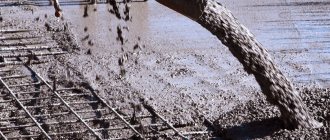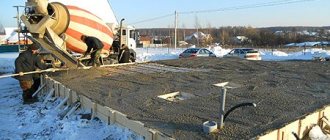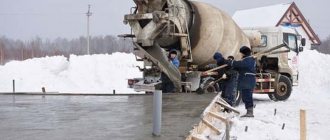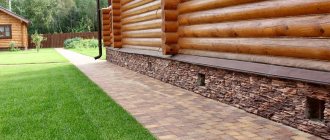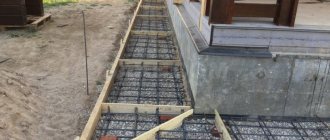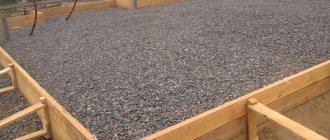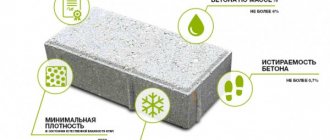I don’t want to build in winter, but there are times when it’s simply necessary! Building a wooden shed and insulating it, or sheathing a metal frame to furnish a shed is a fairly simple task. But what to do if we are talking about capital construction or those structures that simply involve concrete and other mixtures? All of them can freeze and lose their previous characteristics, and therefore you cannot simply mix the solution and pour the foundation in the open winter minus. At a minimum, it is necessary to use special additives that will make the composition harden in the cold and at the same time make it waterproof, durable, and flexible for easy work.
DachaDecor.ru reveals some interesting secrets of professional builders who share their experiences and talk about winter construction.
Winter concrete only with additives
If you decide to build at your dacha in winter, it is imperative to add special components to the concrete and dry mixtures from which the mortar is prepared that regulate the plasticity of the mass, its performance, limit the freezing of water in the mortar, and therefore preserve the characteristics and prevent seams and screeds from becoming damaged. and foundations to crack.
Hardening of the concrete mixture in frost is simply impossible. It freezes, turns into a solid layer of spoiled material, which will no longer produce the specified characteristics, even if after a few days it becomes sunny and warm. It will just be a mass with clumps and cracks.
There is a solution to warm up the concrete while pouring, for example, if it is a screed of several centimeters, which, in theory, should dry quickly. Frost prevents the mixture from hardening, but heating returns the positive temperature, and the layer gradually returns to normal. But there are some “buts”!
For example, an artificial change in temperature affects the characteristics of all components of the mixture, humidity and other indicators, and therefore such concrete will not be of the quality that it could show when hardening under normal conditions. In addition, it is very difficult to heat the screed in the same garage or shed, because the heating must be uniform and stable. This means that you need several heaters, which will also hit your pockets, because they can show considerable electricity bills.
All that remains is to use antifreeze additives that prevent the mixture from freezing, and it gradually gains strength even in subzero temperatures.
These substances work simply - they do not allow the water in the solution to freeze, which means that the overall poured concrete block, screed or foundation will not be “teared” by frost. Moreover, in the cold, all chemical reactions that occur in the concrete mixture during the hardening period slow down significantly. This is the reason why nothing good will come out of ordinary concrete in winter.
What are anti-frost components? Often, these are certain combinations of the following substances - carbon dioxide, soda ash, sodium chloride, ammonium hydroxide, sodium nitrite, ammonium nitrate, sodium nitrate, calcium chloride and others.
There are additives that can be used even at -35°C, and the resulting concrete will be of high quality. But you should definitely remember that the entire mixture is mixed strictly according to the instructions, because in no case should you deviate from its requirements.
Warm styling technology
Heating of the laid mass and the surrounding area by external heat sources during the period when the monolith reaches critical density is called warm concreting. By heating the mass to 50 0 C, the rigidity and strength of the monolith quickly increases. Heating can be provided using electrical energy. Concrete dough is heated no higher than 70 degrees. Such conditions ensure rapid hardening of the monolith.
Apply:
- Electrode heating through the formwork, when heat is released when current passes through the concrete thickness.
- Infrared heating is applied to the reinforcement and special covering material, which warms up the array.
- They use grids of wires laid out on the surface of the poured mass, which generate heat when electricity passes.
- Induction method, when heat from the inductor is transferred to the monolith through the fittings.
All of these methods are energy-consuming, which negatively affects the cost of construction.
Application of heat guns
Tent heating is performed by supplying heated air or steam under a sealed dome installed above a concrete pie. Tested equipment – heat guns. The tent is an awning made of PVC material. The guns are installed inside, on a temporary frame. It takes up to 3 days to reach critical density using heat guns.
Plasticizers for concrete
A very thick composition does not fit well into the formwork; it does not have the necessary plasticity and does not go into hard-to-reach places. Very often, the task of pouring is complicated by reinforcement, especially very thick reinforcement, where the material does not fall at all, leaving voids that negatively affect the strength.
You could add water to the concrete mixture to make it more liquid. But this cannot be done, because then the grade of the composition in terms of water resistance and frost resistance is reduced, and the solution itself loses in quality. Moreover, this cannot be done in winter, when frost can seriously damage the concrete.
Therefore, today, as, in principle, many years ago, plasticizers are used to increase the plasticity of concrete.
At private construction sites in the Soviet Union, ordinary soap, washing powders, as well as lime and clay were often used. But today there are special additives on the market that increase the plasticity of concrete. They work on the principle of facilitating the sliding of concrete mixture particles, that is, they reduce the internal friction of the mass.
Plasticizers are often used in summer cottage construction and in winter; it is only necessary that the preparation recipe meets the requirements as much as possible.
How to use
The choice of additive and the method of its application depends on the condition and material where it will be introduced. Any additives to concrete used at sub-zero temperatures are added to the solution with water, according to the instructions from the manufacturer. After thorough mixing, it is recommended to wait a while for this component to diffuse through the composition.
According to SP 70.13330.2012, in order for the composition to achieve the required strength, it is important that before the temperature of the composition reaches the level for which the additive is designed, it gains no more than 20% of the planned strength.
The consumption of antifreeze additive per 1 cubic meter of material depends on the average daily ambient temperature. Up to -5 degrees it is recommended to add up to 2% of the additive by weight of the solution, up to -10 degrees this figure increases to 3%, up to -15 degrees no more than 4%. In severe frosts, calculations are made individually for each type. The rate of hardening of the solution decreases, and maximum strength is achieved after the end of frost.
When adding plasticizers and PMD, certain operating rules must be followed. The recommended range for the solution to be poured is from +15 to +25ºС. To dissolve additives, a certain amount of water is required, which must be heated, this ensures complete dissolution of the substances. Sand and crushed stone used in the solution are also heated immediately before adding. Cement cannot be heated, as it will lose its astringent properties. The poured solution must be covered, this is especially true during snowfall.
Additives for strength
Similar substances are also used to prepare winter concrete, so that in addition to plasticity, it also receives the necessary strength, and sometimes even with higher performance.
It is worth understanding that adding certain additives to a concrete mixture that correct its properties can affect other properties and future characteristics. Therefore, often instead of one additive, several are added at once. It is necessary to observe many parameters in order to prepare a high-quality composition in unfavorable conditions, including the temperature of the mixture, the amount of aggregates, the intensity of mixing, etc.
Concrete strengthening admixtures consist of different materials, but today the most popular is a product based on silica fume. To prepare it, special raw materials are processed at high temperatures, due to which the additive obtains high chemical activity in water. Microsilica increases the strength of concrete and accelerates the setting process of the mixture.
Increasing the grade of concrete for water resistance and frost resistance
Concrete mixture is a popular construction material for many reasons. First of all, due to reliability and strength, durability and ease of use, the ability to create a wide variety of projects based on the composition, as well as other qualities, including high levels of water resistance and frost resistance.
By improving these qualities, we increase the general characteristics of the material, making it absolutely problem-free in subsequent maintenance and increasing its service life.
It has long been known that special finishing or even waterproofing of concrete does not always cope with the task, and it quickly deteriorates due to exposure to the same atmospheric phenomena. We definitely don’t need this at our dacha, because if we are building a house, garage or even a small gazebo, we need the structure to last for a very long time.
Therefore, it is advisable to use special additives that have a positive effect on the quality and characteristics of concrete, especially when it comes to foundations and plinths, where protection is most needed. They can also include floors in the shower, on the area near the garage, where we often wash the car, in swimming pools, as well as in structures that are built on sites with a high groundwater level.
To obtain the desired characteristics, bituminous substances, surfactants, as well as components with the maximum inclusion of sodium aluminate are introduced into the composition. They work simply - they fill the pores in the finished concrete.
We have already said that often not one, but several additives are used at once, or several characteristics are improved with a certain composition. So, to improve water resistance qualities, you can use silicate glue, the same liquid glass, which increases the grade of concrete in terms of frost resistance and water resistance, and also increases the setting speed of the mixture and future strength.
Economic feasibility of application
The use of antifreeze additives in mortar or concrete, of course, increases the cost of these building materials.
It is economically feasible to use antifreeze additives in winter
However, this requires a cold-blooded calculation about what is more profitable:
- or save on additives, but mothball the construction site for six months, and in warmer months, re-deliver the equipment to the construction site and correct defects that formed during the winter, associated, for example, with the divergence of seams between rows of bricks and the general loss of strength of already erected structures;
- or spend money on antifreeze additives.
In accordance with the standard (specified in SNiP), the cost of a day of construction downtime in a mothballed state in relation to downtime in operating mode is 1:2. Yes, it’s cheaper, but the duration of conservation extends to 180 days.
Even the naked eye can see that it is more economically profitable not to stop construction, but to spend money on anti-frost additives. These financial losses are much less than those that will have to be incurred as a result of the conservation of the facility.
Hardening accelerators
Often such additives are very similar to frost-resistant ones, only the preparation recipe and the percentage of the additive in the composition differ.
Non-reinforced concrete is improved by adding calcium chloride-based compounds, up to 2% by weight of cement. But there is one “but” - the corrosive effect of calcium chloride on metal. Therefore, the additive is not used in reinforced concrete.
For reinforced structures, components are used, the main substances of which are sodium nitrite and potash. More often they are used for preparing mixtures that are used to seal seams and joints between prefabricated reinforced concrete structures. These additives can provide setting and overall quality at fairly low temperatures: when using sodium nitrite - down to -15°C, when using potash - down to -25°C.
It is important to remember that potash-based additives cause the concrete mixture to quickly lose its workability. Therefore, additives should be used immediately before work.
There are many other mixtures and additives that help builders during different periods of work. But today we paid attention to those that can help us with construction at the dacha in bad weather.
It is always possible to make a concrete composition harden in the cold, but not because the water in it simply freezes, but correctly and consistently, so that the future structure acquires the qualities necessary for construction. You just have to choose the right time for your dacha undertakings, or use special materials and additional components that will ensure ease of use and quality of construction.
Thermos method
If the monolith is massive, with a small area of contact with the environment, conservation of heat obtained during the hydration reaction is used. Pouring into insulated formwork, covering with mineral mats and PVC film will make it possible to maintain the temperature of the object at the time the critical density reaches.
The technology of low-temperature filling using the thermos method has become more advanced in recent years. They use mixtures with electric heating in a bunker up to 70-80 0 C. Heating is rapid, in 2 stages, just before laying in an insulated bed. In this case, laboratory control accompanies the process until the mass cools completely. For this purpose, wells are formed in the array at control points. Their locations and sizes are regulated by the standard.
For strip foundations and monolithic slabs, the hot thermos method is suitable. The base for pouring is expanded clay chips, heated to a temperature of 200-300 degrees. After the surface has cooled to 100 0 C, warm concrete is poured with compaction. The entire array is covered with insulating mats and sealed film.
When is steam heating of cement paste used?
Thin-walled structures with a large open area intensively evaporate water when heated. Lack of water makes it difficult to hydrate the monolith and leads to cracking of the surface. The use of steam heating eliminates these problems. Saturated steam heated to 80-95 0 C is supplied to the steam jacket. At the same time, the material itself should not be heated above 70 0. Short-term heating accelerates the hardening of cement composites.
If air heating is used, the casing must be sealed so that the exhaust gases do not carry away moisture.


